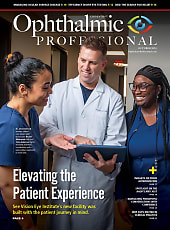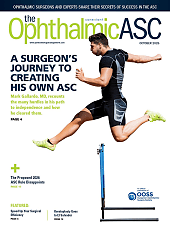Targeted Retinal Photocoagulation
Ultrawide-angle angiography and the PASCAL laser enable a promising new strategy for the treatment of retinal vascular disease.

BY STEVEN D. SCHWARTZ, MD
One of the areas we have been exploring at UCLA is what we call "targeted retinal photocoagulation." Our goal is to determine whether we can effectively treat retinal vascular conditions while minimizing or eliminating the unwanted side effects associated with laser therapy.
This is an opportune time to consider new treatment strategies. First, we have a better understanding of disease pathogenesis. Second, we now have diagnostic and treatment tools that greatly enhance our precision. Targeting requires precision: precision imaging and precision treatment delivery. For example, we can perform ultrawide-angle angiography using either of two systems, the Spectralis HRA (Heidelberg Engineering, Heidelberg, Germany) or the P200MA (Optos, Marlborough, Mass.). Ultrawide-angle angiography allows for high-resolution evaluation of the retinal vasculature. It allows us to detect peripheral perfusion abnormalities, which we do not see with a conventional 30° or 45° view even if we use sweeps or protocols to evaluate the midperiphery. Similarly, spectral domain OCT allows us to appreciate far more detail than we could previously.
In addition, we can perform very low intensity, precise photocoagulation with the PASCAL Photocoagulator. PASCAL delivers short, 10-20 millisecond, low-energy laser pulses. As Mark Blumenkranz, MD, and his colleagues have shown,1,2 these short pulses decrease the amount of thermal energy that spreads to adjacent tissue. So with PASCAL, we have a gentler, more precise treatment that can be delivered routinely.
I first began thinking about how ultrawide-angle angiography and targeted photocoagulation could improve our treatment of retinal vascular disease when a patient came in with 20/40 vision, a history of heavy PRP and persistent maculopathy in 1 eye, and new symptoms in the fellow eye. She had a long history of diabetes. The ultrawide-angle angiogram showed large areas of nonperfusion, some vascular hyperpermeability and early neovascularization in the untreated eye. She was reluctant to undergo conventional laser treatment. I used the targeted retinal photocoagulation (TRP) to treat an area only slightly larger than the ischemic areas. I was able to reduce her symptoms and bring the disease under control. She has been disease-free for 2 years.
Cases such as this led us to wonder whether using ultrawide-angle angiography to guide targeted retinal photocoagulation could be a viable treatment strategy.
RATIONALE FOR THE HYPOTHESIS
More specifically, we sought answers to the following questions: Are retinal features visible with ultrawide-angle angiography, such as peripheral nonperfusion and peripheral late vascular staining, associated with definable treatment outcomes? Can we treat certain areas of the retina with TRP instead of applying conventional panretinal photocoagulation (PRP)? Can TRP treat or contribute to the treatment of diffuse diabetic macular edema (DME) in the setting of peripheral ischemia? Can we combine precise PASCAL photocoagulation and an anti-vascular endothelial growth factor (VEGF) agent to reduce the number of anti-VEGF injections needed, or reduce the area of viable retina we need to treat with laser?
We have reason to believe that the answer to all of these questions may be yes. In 2005, a group including Carmen Puliafito, MD, Thomas Friberg, MD, and my colleagues and I at UCLA used ultrawide-angle angiography to show that widespread peripheral ischemia is present in eyes with diffuse DME. This had been known for some time, but the new imaging modality made it much easier to prove on a consistent basis. Furthermore, many retinal specialists have applied TRP treatments in eyes with branch retinal vein occlusions and have seen macular edema resolve along with retinal neovascularization. Instead of treating the edematous macula directly with laser, treatments targeted only the peripheral areas of nonperfusion, and the edema has resolved.
We know that macular edema is mediated in part by VEGF. But when we think about treating DME with a combination of TRP and anti-VEGF agents, we have at least 3 factors to consider: whether the retina is ischemic or nonischemic; whether the edema is focal or diffuse; and what is happening with regard to the vitreomacular interface.
VEGF production is clearly driven by hypoxia, and we know it occurs in the presence of ischemia in the neurosensory retina. However, we do not know precisely where the VEGF is produced. If we observe capillary nonperfusion, is that the area of retina producing the VEGF? Or is it in a transition area adjacent to the nonperfusion? So where should we apply the laser? We can now see the abnormal areas in the peripheral retina, and more study is needed to determine exactly what to target with laser treatment.
We are also faced with the question of whether to treat the inner or the outer retina. But perhaps we already have the answer. We are seeing so much success using the PASCAL laser to precisely treat the outer retina, I would suggest that we may know where to treat.
TARGETED PHOTOCOAGULATION IN THE CLINICAL SETTING
To determine how TRP guided by ultrawide-angle angiography is working in the clinical setting, we combined our experience at UCLA with that of David Brown, MD, at the Methodist Hospital in Houston. We have data from more than 1000 ultrawide-angle angiograms, and about 40 cases where we treated macular edema with TRP and an anti-VEGF agent. Among those 40 cases, 12 eyes received targeted laser and anti-VEGF therapy only.
One of these is a patient who had a central retinal vein occlusion. She presented with 20/100 visual acuity and large cysts. She was treated with bevacizumab (Avastin, Genentech). By 1 month after treatment, the edema had resolved and vision improved to 20/40. After an additional 4 weeks, the edema began to recur, and we applied TRP. The macular edema initially resolved, but began to recur 10 weeks later. We treated again with TRP and a different anti-VEGF agent, and she has had no recurrence.
In another case, a diabetic patient with macular edema and proliferative retinopathy, TRP was applied to the nonperfused areas and a 1 disc area border or transition zone. With this treatment and 1 anti-VEGF injection, the edema resolved. This patient underwent additional laser treatment peripherally, which resulted in total regression of neovascularization. At 3 months, with no further anti-VEGF treatment, the edema has not returned.
This group of 12 patients is small, but the results are positive. Interestingly, approximately one-third of the group responded extraordinarily well to TRP therapy and an anti-VEGF agent; one-third responded moderately well; and one-third did not seem to respond at all. This fits with the idea that disease in some eyes is mainly VEGF-driven, while in others it may be driven by other factors.
PERIPHERAL ABNORMALITIES AND FEATURES OF DIABETIC RETINOPATHY
Our work with targeted retinal photocoagulation also involves determining whether peripheral retinal vascular abnormalities visible with ultrawide-angle angiography are associated with common manifestations of diabetic retinopathy. We retrospectively reviewed angiograms for 260 eyes of 140 patients, noting macular edema, neovascularization, nonperfusion and what we call "late peripheral vascular leakage," or LPVL.3
We postulated that since diagnostic evidence of diminished or abnormal blood flow may be associated with features of advanced retinopathy, early detection of advanced disease may be possible using improved imaging techniques. Similarly, detection of previously unrecognized diagnostic and outcome associations may provide opportunities for the development of new treatment strategies. We found anterior neovascularization to be strongly associated with peripheral nonperfusion, which is consistent with the existing literature. Posterior neovascularization was strongly associated with peripheral nonperfusion as well.
LPVL was observed frequently in the ultrawide-angle angiograms. We found a significant association of LPVL with posterior neovascularization in our cohort. In fact, all neovascularization was strongly associated with LPVL.
With regard to macular edema, our cohort was smaller. There were 78 eyes with nonproliferative disease and no treatment. The p-value did not reach significance for nonperfusion in the periphery vs any macular edema. However, when we looked at LPVL in the absence of peripheral nonperfusion, the association was significant. Therefore, we believe LPVL may be an indicator of early hypoxia, up-regulation of VEGF, and part of the constellation of new angiographic findings that should be routinely considered to determine which patients to treat with targeted laser photocoagulation (TRP) rather than more conventional means.
USING COMBINATION THERAPY FOR RETINAL VASCULAR DISEASE
Because we can achieve routine precision with the latest diagnostic and treatment tools, better outcomes and improved safety and effectiveness are at hand. Ultrawide-angle angiography appears to allow for early detection of previously unrecognized associations in retinal vascular disease.
In addition, we can say with confidence that the future of care for our patients with retinal vascular disease will be combination therapy, including PASCAL laser photocoagulation. Our experience with targeted retinal photocoagulation seems encouraging, and our work in this area will continue. I personally believe that automated laser photocoagulation with the PASCAL system is likely to become the standard of care. RP
Steven D. Schwartz, MD, is a professor of ophthalmology and chief of the retina division at the Jules Stein Eye Institute, University of California at Los Angeles. He is a member of the OptiMedica Medical Advisory Board.
| REFERENCES |
|---|
|








